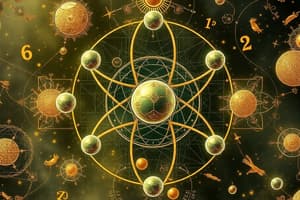Podcast
Questions and Answers
What does the principal quantum number (n) determine about an orbital?
What does the principal quantum number (n) determine about an orbital?
- The shape of the orbital
- The orientation in space
- The number of electrons that can be held
- The energy level and distance from the nucleus (correct)
Which of the following represents an incorrect subshell designation?
Which of the following represents an incorrect subshell designation?
- 5s
- 3p
- 4f
- 2d (correct)
How many orbitals are present in a g subshell?
How many orbitals are present in a g subshell?
- 6
- 10
- 8
- 18 (correct)
Which quantum number determines the orientation of the orbital in space?
Which quantum number determines the orientation of the orbital in space?
What is the maximum number of electrons that can occupy a single orbital?
What is the maximum number of electrons that can occupy a single orbital?
For the 4p subshell, which values correctly represent n and ℓ?
For the 4p subshell, which values correctly represent n and ℓ?
Which change in quantum numbers indicates a transition to a higher energy level?
Which change in quantum numbers indicates a transition to a higher energy level?
Which of the following statements about the angular momentum quantum number (ℓ) is true?
Which of the following statements about the angular momentum quantum number (ℓ) is true?
Flashcards are hidden until you start studying
Study Notes
Quantum Numbers
-
Principal Quantum Number (n): Describes the energy level of an electron and its distance from the nucleus.
- Values: n = 1, 2, 3, ... (positive integers)
- Higher n values: Higher energy levels and larger distances from the nucleus.
- Example: n = 5 has more energy than n = 2
-
Angular Momentum Quantum Number (l): Describes the shape of an electron's orbital.
- Values: l = 0, 1, 2, ..., n-1
- Subshell Letter Designation:
- l = 0: s subshell (spherical)
- l = 1: p subshell (dumbbell shaped)
- l = 2: d subshell (various shapes)
- l = 3: f subshell (various complex shapes)
- and so on...
- Example: 4p subshell has n = 4 and l = 1
-
Magnetic Quantum Number (ml): Describes the orientation of an orbital in space.
- Values: ml = - l, -l + 1, ... 0, ... l - 1, l
- Example: l = 2 (d subshell) has ml = -2, -1, 0, 1, 2, meaning there are 5 different d orbitals.
-
Spin Quantum Number (ms): Describes the intrinsic angular momentum of an electron, visualized as its spin.
- Possible Spins: ms = +1/2 (spin up) or -1/2 (spin down)
- One Orbital: Holds a maximum of two electrons, one with spin up and one with spin down.
Orbital Rules and Relationships
- Number of orbitals in a subshell: 2l + 1
- Example: p subshell (l = 1) has 2(1) + 1 = 3 orbitals.
- Maximum number of electrons in a subshell: 4l + 2
- Example: d subshell (l = 2) has 4(2) +2 = 10 electrons.
- Subshells that cannot exist: 1p (l cannot be greater than n-1), 2d, 6g (same reason), etc.
- Energy levels: Energy levels are defined by the 'n' value, with higher 'n' corresponding to higher energy.
- Within each energy level, the order of energy levels for subshells follows this general pattern:
- n = 1: 1s
- n = 2: 2s, 2p
- n = 3: 3s, 3p, 3d
- n = 4: 4s, 4p, 4d, 4f ... and so on...
Studying That Suits You
Use AI to generate personalized quizzes and flashcards to suit your learning preferences.




